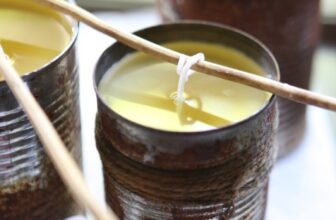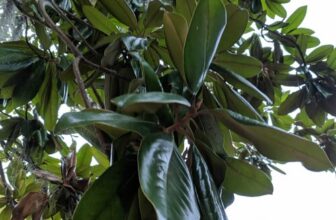You get a tulip, you get a hyacinth, you get a crocus! Yes, folks, fall bulb planting season is upon us. It’s singlehandedly one of the best things you can do this time of year for your future self. Plant fall bulbs now, and they’ll be one of the first blooms to welcome you next spring.

While others may be mourning the loss of summer, I’m over here buzzing about it being fall bulb season. Come September, the displays are full of tons of brilliant bulbs you can plant now for the spring.
One minute I’m shopping for garlic, the next thing you know, I’m leaving with $100 worth of flower bulbs to plant that weekend.
Fall bulbs and spring flowering bulbs are the same thing. One refers to when you plant it, and the other to when they flower.
It can be hard to think about next season’s garden when you’re still enjoying the last of this year’s harvest and blooms, but just a little work now will bring you so much joy next winter.
I’ve got plenty to say about fall bulbs, so let me dive in with all my planting tips. And make sure you read to the end for a can’t miss fall bulb giveaway!
Sponsored Content: A huge thank you to Flowerbulb.eu for sponsoring this post and providing many beautiful photos. Flowerbulb.eu is an invaluable resource for planting fall bulbs and has information on all kinds of unique bulbs you can grow for this spring. Be sure to check them out for more information and tips on growing everything bulbs.

What is a Flower Bulb?
We refer to most as “bulbs,” but some are also corms and tubers. For instance, crocus grow from corms while summer favourites like dahlias and begonias grow from tubers. Their appearance varies slightly, but for the sake of the article, I’ll refer to everything as a bulb! The care is fairly similar for each.
Bulbs are special in that they hold all the food the flower needs to thrive. If you’ve ever seen a package with bulbs already sprouting, that’s why,
Some bulbs are designed for annual planting, others for perennial or naturalizing. Annuals often are bred to be very showy, either in size or colour. Because of how much work it takes for the bulb to produce such a flower, it often won’t bloom again.
Perennials are bred for multiple-year flowering. They can remain in the ground all year round, becoming part of your garden bed plantings.
Naturalized bulbs are meant to multiply and spread. They can work in mass on their own or be part of a bed with other plants. They also work wonderfully in lawns.

When Should I Plant Fall Bulbs?
When you should plant fall bulbs will vary greatly depending on where you live. They must be planted in the fall and before the first hard frost. This gives the bulb a chance to develop some root systems and settle in before winter.
This can be anywhere from September to December, depending on your climate. When in doubt, the package will tell you everything you need to know about when and how to plant the particular bulb.
Ideally, you want to plant them shortly after bringing them home. Most online retailers won’t ship the bulbs to you until they’re ready to plant in your hardiness zone. In the store, they’ll have them a little earlier. You can store them for a little while if necessary, keeping the bulbs between 10°-15°C.

How to Plant Fall Bulbs
Again, the instructions will vary depending on the bulb you’re growing. Each bulb should be planted at different depths, and the sun and water conditions may vary slightly. My instructions below are a good rule of thumb for all bulbs, corms, and tubers.
Good drainage is a universal rule to follow. Bulbs will rot if sitting in any kind of water, so avoid any wet sections in your garden.
Most bulbs thrive in full or partial sun. Since these bulbs bloom in spring, they might enjoy more sunlight than you may think because the trees and shrubs haven’t leafed out yet.
When planting, you can plant them individually or in mass by digging trenches. Typically, smaller plants, like crocus, do well in mass while larger bulbs, such as alliums, work best with individual plantings. I like to work in compost to help improve drainage.
Generally, larger bulbs (2+ inches across) should be planted 6-8 inches deep, and smaller bulbs (1 inch or less) are planted 3-4 inches deep. Depth can change depending on your climate. For our mild winters, that depth is plenty in my garden. It’s best to refer to the package for the exact planting range. Warmer climates can handle the shallowest depth, where colder climates will want to use the maximum of the range.
Plant the bulbs with the pointy side facing up. Place, don’t push the bulb in. Cover with soil and then water generously if the soil isn’t already wet or you’re planting in dry conditions. Add a layer of mulch to help insulate the soil and stop it from drying out.

Caring for Fall Bulbs
Once they’ve been planted, there’s very little work that needs to go into caring for your fall bulbs. They’ll be fine in the winter, sheltered under the cover of snow until they’re ready to emerge in the spring.
Many bulbs will actually naturalize or be perennials in the garden, returning year after year to bring you spring joy. Some bulbs, such as tulips and hyacinths, will bloom abundantly in their first couple of years and slowly taper off.
In the spring, you can snip faded flowers, but it’s important you leave the foliage until it turns completely yellow. The bulbs need time to charge and gather nutrients through the foliage to return the following year.

Planting Bulbs in Pots
Yes, fall bulbs can also be planted in pots! This is a great option for those with a small space or who want to decorate their patio or balcony. I make a container every fall for my front door, and it’s always such a delight come springtime.
For successful bulb containers, you have to make sure the pot is deep enough and has good drainage. Use fresh soil when planting.
You can see exactly how I layer my bulbs, including tulips, daffodils, and crocus. The top layer will bloom first while the ones below make their way up the soil.
In containers, you can pack the bulbs closer than you would in a garden bed. I also like to top mine off with fall annuals, so it looks good in the fall while the bulbs are resting.
You may need to water your containers periodically, especially if they’re under protection from the outside.

Fall Bulb Grow Guides
I’ve written extensively about fall bulbs, including these dedicated guides for some of the most popular bulbs. Check them out for specific growing tips and tricks!
Tulips
Did you know that some tulips are perennials while others are annuals? You want to ensure you know which ones you’re buying to curb your expectations. I recently had the joy of planting over 250 tulip bulbs to grow as cutting flowers. Read these tips for growing tulips for a cutting garden.

Daffodils
Confession: I used to dislike daffodils. The bright yellow heads were always a little too much for me. But then I learned about the sheer number of daffodil varieties, and how versatile they can be.
Here’s how to grow daffodils!

Alliums
Alliums have long been one of my spring favourites, particularly the giant balls known as Globmaster alliums. As part of the onion family, you can truly grow some wacky and wonderful alliums.
Check out some of the allium varieties.

Crocus
The true herald of spring is not the robin, but the crocus flowers. I often see these flowers blooming even when there is snow or frost still on the ground. They’re great for mass plantings in garden beds and are a go-to for bulb lawns and naturalizing.
Plant and grow crocus with the help of my guide.

Specialty Bulbs
Everyone knows tulips and daffodils, but not everyone is as familiar with other fun fall bulbs, such as the checkered lily or Dutch iris. Here are 12 extraordinary fall bulbs to consider planting.

Naturalizing Bulbs
Naturalizing is a gardener’s dream. This is when the bulbs produce more bulbs on their own, naturally multiplying their numbers each subsequent year. I’ve done tons of work naturalizing bulbs in my front lawn. You can find all my tips for naturalizing garden beds and lawns here!

Fall Bulb FAQ
Yes, and it’s a great way to bring some beauty before the perennials leaf out and everything else isn’t blooming yet. It can be difficult to plant in these areas as the soil is hard and there are root systems to navigate. You’re more likely to individually plant them. An auger drill attachment can help, though you should make the hole as small as possible.
It should be noted that the success rate may be lower as the bulbs are competing with these large root systems for nutrients. You can read about my experience planting on my sidewalk strip under oak trees in this post.
Squirrels and other small mammals are attracted to the fresh soil after you’ve planted a bulb. You want to try to cover up any indication of fresh soil. Mulch can help hide this.
You also want to remove anything that may be attracting them to the area, such as garbage, compost, or bird feeders.
If you’re really concerned, you can place a hard wire over the top of the bulbs.
Personally, I plant with the knowledge that some of my bulbs may be dug up. It seems only fair they get a few bulbs too!
Earlier is usually better, but it depends on your climate. The planting should be done before the hard frost to allow the bulb to establish a root system. However, if you’re experiencing a warm fall, you may want to wait later to avoid hot conditions.
I don’t fertilize much in my garden, as I work hard to feed my soil by adding layers of compost and leaf mulch every year. Only if you have poor soil conditions, you may want to fertilize. This is especially helpful if you have perennial bulbs and want them to bloom prolifically the following year. Fertilize after the bulbs have finished flowering in the spring.
Fall Bulb Giveaway!
I’m thrilled to partner with Flowerbulb.eu to give $100 worth of fall bulbs to one lucky Garden Therapy reader.
To enter, leave a comment on this post letting me know what fall bulbs you want to plant in your garden this year.
Contest is open to U.S. residents only and runs until October 3, 11:59 PM. The winner will be chosen using a random number generator. Good luck!!

That rounds up all of my fall bulb tips and guides! If you have any questions, leave them in the comments below or check out Flowerbulb.eu for more helpful information about planting bulbs.
More Fall Bulb Planting Tips

A city girl who learned to garden and it changed everything. Author, artist, Master Gardener. Better living through plants.




